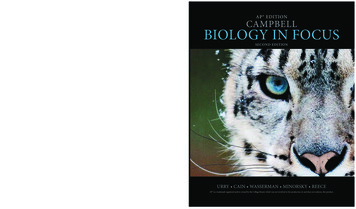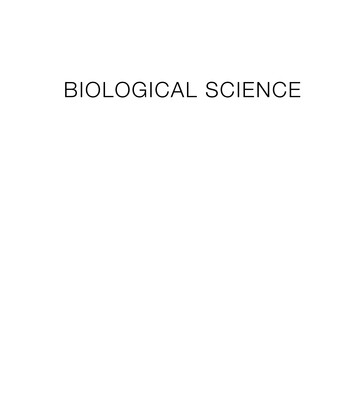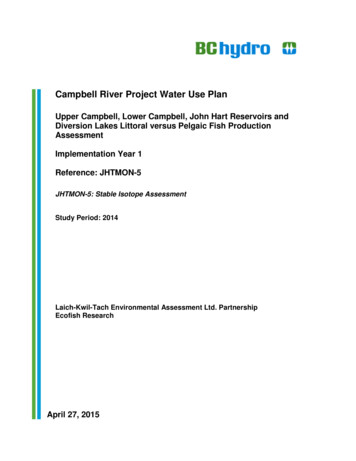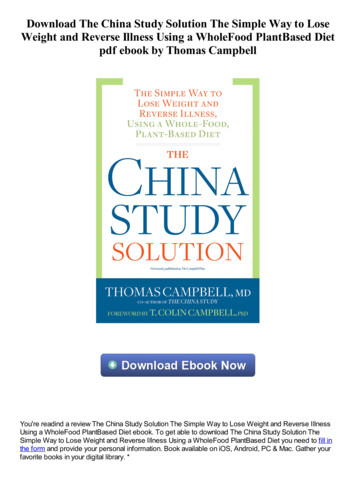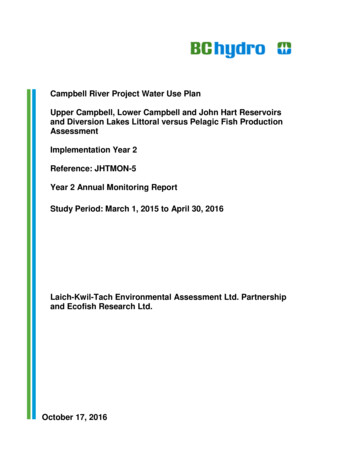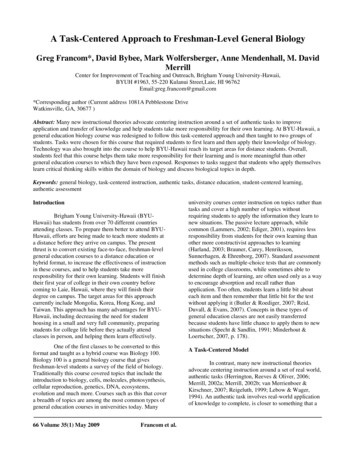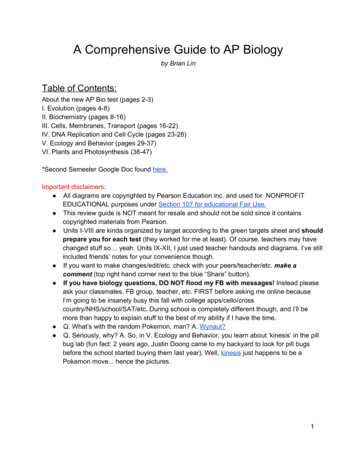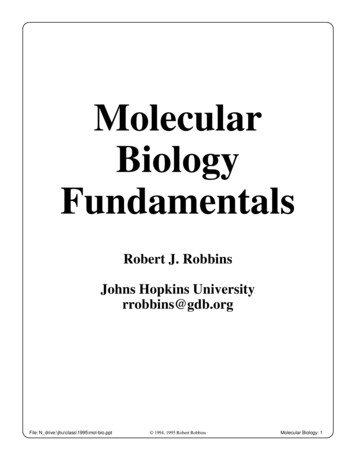
Transcription
C a m p b e l lBiologyConcepts & ConnectionsA0 fm camp.indd 1# 111009 Cust: Pearson Education / NJ / CHET Au: Campbell Pg. No. iTitle: Biology: Concepts and Connections Server:C/M/Y/KShort / NormalDESIGN SERVICES OFS4carlislePublishing Services08/11/13 2:40 PM
A0 fm camp.indd 208/11/13 2:40 PM
C a m p b e l lBiologyConcepts & ConnectionsC ANA D IAN E D ITIONJane B. ReeceBerkeley, CaliforniaMartha R.TaylorCornell UniversityEric J. SimonNew England CollegeJean L. DickeyClemson UniversityKevin G-E. ScottUniversity of ManitobaTorontoA0 fm camp.indd 308/11/13 2:40 PM
Vice-President, Editorial Director: Gary BennettSenior Acquisitions Editor: Lisa RahnMarketing Managers: Kim Ukrainec and Jenna WulffSupervising Developmental Editor: Maurice EssesLead Project Manager: Avinash ChandraProject Manager: Sarah GallagherProgram Manager: Darryl KamoManufacturing Coordinator: Jane SchellProduction Editor: Roxanne KlaasCopy Editor: Deborah Cooper-BullockProofreader: Julie LewisCompositor: S4Carlisle Publishing ServicesPhoto and Permissions Researcher: Terri RothmanCover and Interior Designer: Anthony LeungCover Image: Breene YuenCredits and acknowledgments for material borrowed from other sources and reproduced, with permission,in this textbook appear on pages C1-C9.Original edition published by Pearson Education, Inc., Upper Saddle River, New Jersey, USA. Copyright 2012Pearson Education, Inc. This edition is authorized for sale only in CanadaIf you purchased this book outside the United States or Canada, you should be aware that it has been imported without the approval of the publisher or the author.Copyright 2014 Pearson Canada Inc. All rights reserved. Manufactured in the United States of America. Thi publication is protected by copyright and permission should be obtained from the publisher prior to any p rohibitedreproduction, storage in a retrieval system, or transmission in any form or by any means, electronic, m echanical,photocopying, recording, or likewise. To obtain permission(s) to use material from this work, please submit a w rittenrequest to Pearson Canada Inc., Permissions Department, 26 Prince Andrew Place, Don Mills, Ontario, M3C 2T8, orfax your request to 416-447-3126, or submit a request to Permissions Requests at www.pearsoncanada.ca.10 9 8 7 6 5 4 3 2 1 [CJV]Library and Archives Canada Cataloguing in PublicationCampbell biology : concepts & connections / Jane B. Reece . [et al.]. -- Canadian ed.Includes index.ISBN 978-0-321-77448-41. Biology--Textbooks. I. Reece, Jane B.QH308.2.C343 2013570C2012-908453-0A0 fm camp.indd 4# 111009 Cust: Pearson Education / NJ / CHET Au: Campbell Pg. No. ivTitle: Biology: Concepts and Connections Server:C/M/Y/KShort / NormalDESIGN SERVICES OFS4carlislePublishing Services08/11/13 2:40 PM
About the AuthorsJane B. Reece has worked in bi-ology publishing since 1978, when shejoined the editorial staff ofBenjamin Cummings. Her educationincludes an A.B. in biology fromHarvard University (where she wasinitially a philosophy major), an M.S.in microbiology from RutgersUniversity, and a Ph.D. in bacteriology from the University of California,Berkeley. At UC Berkeley and later as a postdoctoral fellow ingenetics at Stanford University, her research focused ongenetic recombination in bacteria. Dr. Reece taught biology atMiddlesex County College (New Jersey) and Queens boroughCommunity College (New York). During her 12 years as aneditor at Benjamin Cummings, she played a major role in anumber of successful textbooks. She is lead author of CampbellBiology, Ninth Edition, and coauthor of Campbell EssentialBiology, Fourth Edition, and Campbell Essential Biology withPhysiology, Third EditionMartha R. Taylor has been teaching biology for more than 35 years.She earned her B.A. in biology fromGettysburg College and her M.S. andPh.D. in science education fromCornell University. She was assistantdirector of the Office of InstructionaSupport at Cornell for 7 years.Dr. Taylor has taught introductorybiology for both majors and nonmajors at Cornell University and is currently a lecturer in theLearning Strategies Center teaching supplemental biologycourses. Her experience working with students in classrooms,in laboratories, and with tutorials has increased her commitment to helping students create their own knowledge of andappreciation for biology. She has been the author of the Student Study Guide for all nine editions of Campbell Biology.Eric J. Simon is an associate pro-fessor in the Department of Biologyand Health Science at New EnglandCollege, in Henniker, New Hampshire.He teaches introductory biology to science majors and nonscience majors, aswell as upper-level courses in genetics,microbiology, tropical marine biology,and molecular biology. Dr. Simon received a B.A. in biology and computerscience and an M.A. in biology from Wesleyan University anda Ph.D. in biochemistry from Harvard University. His researchfocuses on innovative ways to use technology to improveteaching and learning in the science classroom, particularly fornonscience majors. Dr. Simon is the lead author of CampbellEssential Biology, Fourth Edition, and Campbell EssentialBiology with Physiology, Third EditionJean L. Dickey is a professor ofbiology at Clemson University. Shehad no idea that science was interesting until her senior year in highschool, when a scheduling problemlanded her in an advanced biologycourse. Abandoning plans to studyEnglish or foreign languages, she enrolled in Kent State University asa biology major. After receiving herB.S. in biology, she went on to earn a Ph.D. in ecology andevolution from Purdue University. Since joining the faculty atClemson in 1984, Dr. Dickey has specialized in teaching nonscience majors, including a course designed for preserviceelementary teachers and workshops for in-service teachers.She also developed an investigative laboratory curriculum forgeneral biology. Dr. Dickey is author of Laboratory Investigations for Biology, Second Edition, and coauthor of CampbellEssential Biology, Fourth Edition, and Campbell EssentialBiology with Physiology, Third EditionNeil A. Campbell (1946–2004)combined the inquiring nature of aresearch scientist with the soul of acaring teacher. Over his 30 years ofteaching introductory biology to bothscience majors and nonscience majors, many thousands of students hadthe opportunity to learn from him andbe stimulated by his enthusiasm forthe study of life. While he is greatlymissed by his many friends in the biology community, hiscoauthors remain inspired by his visionary dedication to education and are committed to searching for ever better ways toengage students in the wonders of biology.Kevin G-E. Scott is a senior instructor at the University of Manitobawhere he teaches introductory biologyfor science majors and nonsciencemajors; ecology for nonbiology majors;and upper-level animal physiology laboratories. In the past, he has also taughtcourses in immunology, parasitology,human anatomy and physiology, andmicrobiology. Dr. Scott received a B.Sc.in zoology and a Ph.D. in zoology and cellular, molecular, andmicrobial biology at the University of Calgary. As an instructor,Dr. Scott has centred his career on teaching and the classroom,where he shares his excitement for biology. This is the first tiDr. Scott has authored a biology textbook.vA0 fm camp.indd 5# 111009 Cust: Pearson Education / NJ / CHET Au: Campbell Pg. No. vTitle: Biology: Concepts and Connections Server:C/M/Y/KShort / NormalDESIGN SERVICES OFS4carlislePublishing Services08/11/13 2:40 PM
Brief Contents1 Exploring Biology 123Nutrition in Plants 48924Control Systems in Plants 506UNIT IThe Living CellUNIT VI192The Essential Chemistry of Lif3The Compounds of Cell4Cellular Structure 585Cellular Function 826How Cells Harvest Chemical Energy 1007Photosynthesis 119Structure and Function of Animals 5252038UNIT IICellular Reproduction and Genetics 137Unifying Concepts of Animal Structureand Function 52626Nutrition in Animals 54627Gas Exchange 56928Circulation and Waste Removal 58529Hormones and Endocrine Systems 61130Animal Reproduction and Development 63031Neurons and Nervous Systems 66032Sensation 6858The Cellular Basis of Reproduction and Inheritanc9Patterns of Inheritance 16833Animal Locomotion 70410Molecular Genetics 19934Animal Immune Systems 72211Gene Expression 22412DNA Technology and Genomics 246UNIT IIIConcepts of Evolution 26913825UNIT VIIEcology 74335The Biosphere: An Introduction to Earth’s DiverseEnvironments 74436Behavioural Ecology 76713Evolution: In the Beginning 27037Population Ecology 78914Mechanisms of Evolution 28938Community Ecology 80615Speciation and Phylogeny 31139Symbioses 82540Ecosystem Ecology 84541Conservation and Sustainability 858UNIT IVThe Evolution of Biodiversity 33716Viruses and Other Acellular “Life” 338Appendix A: The Periodic Table A-117Bacteria and Other Prokaryotes 359Appendix B: The Amino Acids of Proteins A-218Biodiversity of Protists and Fungi 37619Biodiversity of Plants 396Appendix C: Some Organic Functional Groups and TheirProperties A-320Biodiversity of Invertebrate Animals 415Appendix D: The Language of Biology A-521Biodiversity of Vertebrate Animals 440Appendix E: Answers to Chapter Review QuestionsGlossary G-1UNIT VPlants: Structure and Function 46522viA0 fm camp.indd 6A-16Plant Structure, Growth, and Reproduction 466Credits C-1Index I-1# 111009 Cust: Pearson Education / NJ / CHET Au: Campbell Pg. No. viTitle: Biology: Concepts and Connections Server:C/M/Y/KShort / NormalDESIGN SERVICES OFS4carlislePublishing Services08/11/13 2:40 PM
Table of Contents1Exploring Biology 1Themes in the Study of Biology 31.11.21.31.4All forms of life share common properties 3In life’s hierarchy of organization, new propertiesemerge at each level 4Cells are the structural and functional units of life 5Organisms interact with their environment, exchangingmatter and energy 6Evolution, the Core Theme of Biology 71.51.61.7The unity of life is based on DNA and a commongenetic code 7The diversity of life can be arranged into threedomains 7Evolution explains the unity and diversity of life 9The Scientific Method 101.81.9Scientific inquiry is used to ask and answer questionsabout nature 10Scientists form and test hypotheses and share theirresults 11Biology and Everyday Life 141.101.111.12Biology, technology, and society areconnected in important ways 14EVOLUTION CONNECTION Evolution is connected to oureveryday lives 14RUMOUR HAS IT Do malicious rumours spread likediseases? 15BIOLOGY AND SOCIETYChapter Review 162.62.72.82.92.10Water’s Life-Supporting Properties 312.112.122.132.142.152.162.1733.13.3The Essential Chemistry of Life 202.12.22.32.4Organisms are composed of elements, in combinationscalled compounds 22EVERYDAY BIOLOGY Trace elements are common additivesto food and water 23Atoms consist of protons, neutrons, and electrons 24EVERYDAY BIOLOGY Radioisotopes can help or harm us 25Chemical Bonds 262.5A0 fm camp.indd 7The distribution of electrons determines an atom’schemical properties 26Life’s molecular diversity is based on the properties ofcarbon 40A few chemical groups are key to the functioning ofbiological molecules 41Cells make a huge number of large molecules from alimited set of small molecules 42Carbohydrates 433.43.53.63.7Elements, Atoms, and Compounds 22The Compounds of Cells 38Introduction to Organic Compounds 40UNIT I2Hydrogen bonds make liquid water cohesive 31Water’s hydrogen bonds moderate temperature 31Ice is less dense than liquid water 32Water is the solvent of life 32The chemistry of life is sensitive to acidic and basicconditions 33EVERYDAY BIOLOGY Acid precipitation and oceanacidification threaten the environmen 34EVOLUTION CONNECTION The search for extraterrestrial lifecentres on the search for water 34Chapter Review 353.2The Living CelCovalent bonds join atoms into molecules throughelectron sharing 26Ionic bonds are attractions between ions of oppositecharge 28Hydrogen bonds are weak bonds important in thechemistry of life 28Chemical reactions make and break chemical bonds 29RUMOUR HAS IT Is there a chemical indicator in swimmingpools that detects urine? 30Monosaccharides are the simplest carbohydrates 43Two monosaccharides are linked to form adisaccharide 44RUMOUR HAS IT Is high-fructose corn syrup to blame forobesity? 44Polysaccharides are long chains of sugar units 45Proteins 463.83.93.10Proteins are made from amino acids linked by peptidebonds 46A protein’s specific shape determines its functio 47A protein’s shape depends on four levels of structure 48Nucleic Acids 503.113.123.13DNA and RNA are the two types of nucleic acids 50Nucleic acids are polymers of nucleotides 51EVOLUTION CONNECTION Lactose tolerance is a recent event inhuman evolution 52# 111009 Cust: Pearson Education / NJ / CHET Au: Campbell Pg. No. viiTitle: Biology: Concepts and Connections Server:C/M/Y/KShort / NormalviiDESIGN SERVICES OFS4carlislePublishing Services08/11/13 2:40 PM
Lipids 533.143.153.16Fats are lipids that are mostly energy-storagemolecules 53Phospholipids and steroids are important lipids with avariety of functions 53EVERYDAY BIOLOGY Cholesterol must be specially packagedfor transport in the blood 545Membrane Structure and Function 845.15.2Chapter Review 5545.3Cellular Structure 585.45.5Introduction to the Cell 604.14.24.34.4Microscopes reveal the world of the cell 60The small size of cells relates to the need to exchangematerials across the plasma membrane 62Prokaryotic cells are structurally simpler than eukaryoticcells 63Eukaryotic cells are partitioned into functionalcompartments 645.75.85.94.55.11The Endomembrane System 684.74.84.94.104.114.12Overview: Many cell organelles are connected throughthe endomembrane system 68The endoplasmic reticulum is a biosynthetic factor 69The Golgi apparatus finishes, sorts, and ships celproducts 70Lysosomes are digestive compartments within a cell 71Vacuoles function in the general maintenanceof the cell 71A review of the structures involved in manufacturingand breakdown 72Energy-Converting Organelles 724.134.144.15Mitochondria harvest chemical energy from food 72Chloroplasts convert solar energy to chemical energy 73EVOLUTION CONNECTION Mitochondria and chloroplastsevolved by endosymbiosis 73The Cytoskeleton and Cell Surfaces 744.164.174.184.194.204.214.22Are the organelles of a cell free-floatingin a cytoplasm soup? 74Cilia and flagella move when microtubules ben 75EVERYDAY BIOLOGY Problems with sperm motility may beenvironmental or genetic 76The extracellular matrix of animal cells functions insupport and regulation 77Three types of cell junctions are found in animaltissues 78Cell walls enclose and support plant cells 78Review: Eukaryotic cell structures can be grouped on thebasis of four main functions 79RUMOUR HAS ITChapter Review 80Table of ContentsA0 fm camp.indd 8Membranes are fluid mosaics of lipids and proteins withmany functions 84EVOLUTION CONNECTION Membranes form spontaneously, acritical step in the origin of life 85Passive transport is diffusion across a membrane with noenergy investment 85Osmosis is the diffusion of water across a membran 86Water balance between cells and their surroundings iscrucial to organisms 86Transport proteins can facilitate diffusion acrossmembranes 87Cells expend energy in the active transport of a solute 88Exocytosis and endocytosis transport large moleculesacross membranes 88Energy and the Cell 905.104.6viii5.6The Nucleus and Ribosomes 66The nucleus is the cell’s genetic control centr 66Ribosomes make proteins for use in the celland for export 67Cellular Function 82Cells transform energy as they perform work 90Chemical reactions either release or store energy 91ATP drives cellular work by coupling exergonic andendergonic reactions 92How Enzymes Function 935.125.135.145.155.16Enzymes speed up the cell’s chemical reactions bylowering energy barriers 93A specific enzyme catalyzes each cellular reactio 94Enzyme inhibitors can regulate enzyme activity in a cell 95RUMOUR HAS IT Does eating raw vegetables providevaluable enzymes for digestion? 96EVERYDAY BIOLOGY Many drugs, pesticides, and poisons areenzyme inhibitors 97Chapter Review 976How Cells Harvest ChemicalEnergy 100Cellular Respiration: Aerobic Harvesting of Energy 1026.16.26.36.46.5Photosynthesis and cellular respiration provide energyfor life 102Breathing supplies O2 for use in cellular respiration andremoves CO2 102Cellular respiration banks energy in ATP molecules 103EVERYDAY BIOLOGY The human body uses energy from ATPfor all its activities 103Cells tap energy from electrons “falling” from organicfuels to oxygen 104Stages of Cellular Respiration 1056.66.76.8Overview: Cellular respiration occurs in three mainstages 105Glycolysis harvests chemical energy by oxidizing glucoseto pyruvate 106Pyruvate is oxidized prior to the citric acid cycle 108# 111009 Cust: Pearson Education / NJ / CHET Au: Campbell Pg. No. viiiTitle: Biology: Concepts and Connections Server:C/M/Y/KShort / NormalDESIGN SERVICES OFS4carlislePublishing Services08/11/13 2:40 PM
6.96.106.116.12The citric acid cycle completes the oxidation of organicmolecules, generating many NADH and FADH2molecules 108Most ATP production occurs by oxidativephosphorylation 110EVERYDAY BIOLOGY Interrupting cellular respiration canhave both harmful and beneficial effec 111Review: Each molecule of glucose yields many moleculesof ATP 1127.137.14Photosynthesis may moderate globalclimate change 132Scientific study of Earth’s ozone layer has globalsignificanc 133EVERYDAY BIOLOGYChapter Review 134UNIT IICellular Reproductionand GeneticsFermentation: Anaerobic Harvesting of Energy 1126.136.14Fermentation enables cells to produce ATP withoutoxygen 112RUMOUR HAS IT Do African elephants get drunk fromfermented marula fruit and wreak havoc? 114Connections Between Metabolic Pathways 1156.156.166.17Glycolysis evolved early in thehistory of life on Earth 115Cells use many kinds of organic molecules as fuel forcellular respiration 115Food molecules provide raw materials forbiosynthesis 116EVOLUTION CONNECTIONChapter Review 11778Cell Division and Reproduction 1408.18.28.48.5An Overview of Photosynthesis 1218.67.18.77.27.37.47.5Autotrophs are the producers of the biosphere 121Photosynthesis occurs in chloroplasts in plant cells 122Scientists traced the process of photosynthesis by usingisotopes 123Photosynthesis is a redox process, as is cellularrespiration 123Overview: The two stages of photosynthesis are linked byATP and NADPH 124The Light-Dependent Reactions: Converting Solar Energy toChemical Energy 1257.67.77.87.9Do plants absorb all light duringphotosynthesis? 125Photosystems capture solar energy 126Two photosystems connected by an electron transportchain generate ATP and NADPH 127Chemiosmosis powers ATP synthesis in the lightdependent reactions 128RUMOUR HAS ITThe Calvin Cycle: Reducing CO2 to Sugar 1297.107.11ATP and NADPH power sugar synthesis in the Calvincycle 129EVOLUTION CONNECTION Other methods of carbon fixationhave evolved in hot, dry climates 130Photosynthesis Reviewed and Extended 1317.12Review: Photosynthesis uses light energy,carbon dioxide, and water to make organicmolecules 131Cell division plays many important roles in the livesof organisms 140Prokaryotes reproduce by binary fissio 141The Eukaryotic Cell Cycle and Mitosis 1428.3Photosynthesis 119The Cellular Basis of Reproductionand Inheritance 1388.88.98.108.11The large, complex chromosomes of eukaryotesduplicate with each cell division 142The cell cycle multiplies cell 143Cell division is a continuum of dynamic changes 144Cytokinesis differs for plant and animal cell 146Anchorage, cell density, and chemical growth factorsaffect cell divisio 147Growth factors signal the cell cycle control system 148EVERYDAY BIOLOGY Growing out of control, cancer cellsproduce malignant tumours 149RUMOUR HAS IT Are sharks immune to cancer? 150Review: Mitosis provides for growth, cell replacement,and asexual reproduction 151Meiosis and Crossing Over 1528.128.138.148.158.168.178.18Chromosomes are matched in homologous pairs 152Gametes have a single set of chromosomes 152Meiosis reduces the chromosome number from diploidto haploid 153Mitosis and meiosis have important similaritiesand difference 156Independent orientation of chromosomes in meiosisand random fertilization lead to varied offsprin 157Homologous chromosomes may carry different versionsof genes 158Crossing over further increases genetic variability 158Alterations of Chromosome Number and Structure 1608.198.208.21A karyotype is a photographic inventory of anindividual’s chromosomes 160EVERYDAY BIOLOGY An extra copy of chromosome 21 causesDown syndrome 161Accidents during meiosis can alter chromosomenumber 162Table of ContentsA0 fm camp.indd 9# 111009 Cust: Pearson Education / NJ / CHET Au: Campbell Pg. No. ixTitle: Biology: Concepts and Connections Server:C/M/Y/KShort / NormalixDESIGN SERVICES OFS4carlislePublishing Services08/11/13 2:40 PM
8.228.238.24EVERYDAY BIOLOGY Abnormal numbers of sex chromosomesdo not usually affect surviva 162EVOLUTION CONNECTION New species can arise from errors incell division 163Alterations of chromosome structure can cause birthdefects and cancer 164Chapter Review 16599.29.39.49.59.69.79.89.9Patterns of Inheritance 1689.119.129.139.149.15Experimental genetics began in an abbey garden 170Mendel’s law of segregation describes the inheritance ofa single character 171Homologous chromosomes bear the alleles for eachcharacter 173The law of independent assortment is revealed bytracking two characters at once 173Geneticists can use the testcross to determine unknowngenotypes 175Mendel’s laws reflect the rules of probabilit 176EVERYDAY BIOLOGY Genetic traits in humans can be trackedthrough family pedigrees 177EVERYDAY BIOLOGY Many inherited disorders in humans arecontrolled by a single gene 178BIOLOGY AND SOCIETY New technologies can provide insightinto one’s genetic legacy 180Dominance is not always complete 182Many genes have more than two alleles in thepopulation 183A single gene may affect many phenotypiccharacters 184A single character may be influenced by manygenes 184EVOLUTION CONNECTION Human pigmentation has repeatedlychanged as our ancestors migrated 186The environment affects many characte 187The Chromosomal Basis of Inheritance 1889.169.179.189.19Chromosome behaviour accounts for Mendel’s laws 188Genes on the same chromosome tend to be inheritedtogether 189Crossing over produces new combinations of alleles 190Geneticists use crossover data to map genes 192Sex Chromosomes and Sex-Linked Genes 1929.209.219.229.23Chromosomes determine sex in many species 192RUMOUR HAS IT Are human males on the verge ofextinction? 194Sex-linked genes exhibit a unique pattern ofinheritance 194EVERYDAY BIOLOGY Human sex-linked disorders affectmostly males 195Chapter Review 196x10.110.2Experiments showed that DNA is the geneticmaterial 201DNA and RNA are polymers of nucleotides 202DNA is a double-stranded helix 204DNA Replication 20610.4Variations on Mendel’s Laws 1829.10The Structure of the Genetic Material 20110.3Mendel’s Laws 1709.110 Molecular Genetics 19910.5DNA replication depends on specific base pairin 206DNA replication proceeds in two directions at manysites simultaneously 207The Flow of Genetic Information from DNA to RNAto Protein 0.1610.1710.1810.19The DNA genotype is expressed as proteins,which provide the molecular basis for phenotypictraits 208Genetic information written in codons is translated intoamino acid sequences 209The genetic code dictates how codons are translated intoamino acids 210Transcription produces genetic messages in the formof RNA 212Eukaryotic RNA is processed before leaving the nucleusas mRNA 213Transfer RNA molecules serve as interpreters duringtranslation 213Ribosomes build polypeptides 215An initiation codon marks the start of an mRNAmessage 215Elongation adds amino acids to the polypeptide chainuntil a stop codon terminates translation 216Review: The flow of genetic information in the cell iDNA S RNA S protein 217Mutations can change the meaning of genes 218EVERYDAY BIOLOGY Suntanning damages DNA leading tomutations 219RUMOUR HAS IT Are all mutations detrimental toorganisms? 220EVOLUTION CONNECTION Mutations are at the centre of theevolution of antibiotic resistance in bacteria 221Chapter Review 22211 Gene Expression 224Control of Gene Expression 22611.111.211.311.4Proteins interacting with DNA turn prokaryotic geneson or off in response to environmental change 226Chromosome structure and chemical modifications canaffect gene expressio 228RUMOUR HAS IT Are identical twins really identical? 230Complex assemblies of proteins control eukaryotictranscription 230Table of ContentsA0 fm camp.indd 10# 111009 Cust: Pearson Education / NJ / CHET Au: Campbell Pg. No. xTitle: Biology: Concepts and Connections Server:C/M/Y/KShort / NormalDESIGN SERVICES OFS4carlislePublishing Services08/11/13 2:40 PM
11.511.611.711.811.911.1011.11Eukaryotic RNA may be spliced in more than oneway 231Small RNAs play multiple roles in controlling geneexpression 232Later stages of gene expression are also subject toregulation 232Review: Multiple mechanisms regulate gene expressionin eukaryotes 233Cell signalling and cascades of gene expression directanimal development 235Signal transduction pathways convert messages receivedat the cell surface to responses within the cell 236EVOLUTION CONNECTION Cell-signalling systems appearedearly in the evolution of life 236Cloning of Plants and Animals 23711.1211.1311.14Plant cloning shows that differentiated cells may retainall of their genetic potential 237Nuclear transplantation can be used to cloneanimals 238EVERYDAY BIOLOGY Therapeutic cloning can produce stemcells with great medical potential 238The Genetic Basis of Cancer 23911.1511.1611.1711.18Cancer results from mutations in genes that control celldivision 239Multiple genetic changes underlie the developmentof cancer 240Faulty proteins can interfere with normal signaltransduction pathways 241EVERYDAY BIOLOGY Lifestyle choices can reduce the riskof cancer 242Chapter Review 24312 DNA Technology and Genomics 246Gene Cloning 24812.112.212.312.412.5Genes can be cloned in recombinant plasmids 248Enzymes are used to “cut and paste” DNA 250Cloned genes can be stored in genomic libraries 251Reverse transcriptase can help to make genes forcloning 251Nucleic acid probes identify clones carrying specificgenes 252DNA Profiling 25812.1112.1212.1312.1412.1512.16Genomics binant cells and organisms can mass-producegene products 252EVERYDAY BIOLOGY DNA technology has changed thepharmaceutical industry and medicine 254EVERYDAY BIOLOGY Genetically modified organisms aretransforming agriculture 255BIOLOGY AND SOCIETY Genetically modified organisms raiseconcerns about human and environmental health 256EVERYDAY BIOLOGY Gene therapy may someday help to treata variety of diseases 257Genomics is the scientific study of whole genome 263RUMOUR HAS IT Is 98% of human DNA actually unusedjunk? 264The whole-genome shotgun method of sequencing agenome can provide a wealth of data quickly 265Proteomics is the scientific study of the full set ofproteins encoded by a genome 265EVOLUTION CONNECTION Genomes hold clues to humanevolution 266Chapter Review 266UNIT IIIConcepts of Evolution13 Evolution: In the Beginning 270Darwin’s Theory of Evolution 27213.113.213.313.413.513.6Genetically Modified Organisms 25212.6The analysis of genetic markers can produce a DNAprofil 258The PCR method is used to amplify DNA sequence 259Gel electrophoresis sorts DNA molecules by size 259STR analysis is commonly used for DNA profilin 260DNA profiling has provided evidence in many forensicinvestigations 261RFLPs can be used to detect differences in DNAsequences 26213.7A sea voyage helped Darwin frame his theory ofevolution 272Darwin proposed natural selection as the mechanism ofevolution 274EVERYDAY BIOLOGY Scientists can observe natural selectionin action 275The study of fossils provides strong evidence forevolution 276Many types of scientific evidence support theevolutionary view of life 278EVOLUTION CONNECTION Homologies indicate patterns ofdescent that can be shown on an evolutionary tree 279RUMOUR HAS IT Does the theory of evolution explain theorigins of life? 280Early Earth and the Origin of Life 28013.813.913.10Conditions on early Earth made the origin of lifepossible 280Experiments show that the abiotic synthesis of organicmolecules is possible 281Stages in the origin of the first cells probably includedthe formation of polymers, protocells, and selfreplicating RNA 282Table of ContentsA0 fm camp.indd 11# 111009 Cust: Pearson Education / NJ / CHET Au: Campbell Pg. No. xiTitle: Biology: Concepts and Connections Server:C/M/Y/KShort / NormalxiDESIGN SERVICES OFS4carlislePublishing Services08/11/13 2:40 PM
Major Events in the History of Life 283Mechanisms of Speciation 31713.1115.413.1213.13The origins of single-celled and multicellular organismsand the colonization of land were key events in life’shistory 283The actual ages of rocks and fossils mark geologic time 285The fossil record documents the history of lif 285Chapter Review 28714 Mechanisms of Evolution 289The Evolution of Populations 29114.114.214.314.4Do individuals evolve? 291Mutation and sexual reproduction produce the geneticvariation that makes evolution possible 291The Hardy-Weinberg equation can test whether apopulation is evolving 293EVERYDAY BIOLOGY The Hardy-Weinberg equation is usefulin public health science R HAS ITMechanisms of Microevolution 29514.515.5Natural selection, genetic drift, and gene flow can causmicroevolution 295Natural selection is the only mechanism thatconsistently le
Biology, Ninth Edition, and coauthor of Campbell Essential Biology, Fourth Edition, and Campbell Essential Biology with Physiology, Third Edition Martha R. Taylor has been teach-ing biology for more than 35 years. She earned her B.A. in biology from Gettysburg College and her M.S

